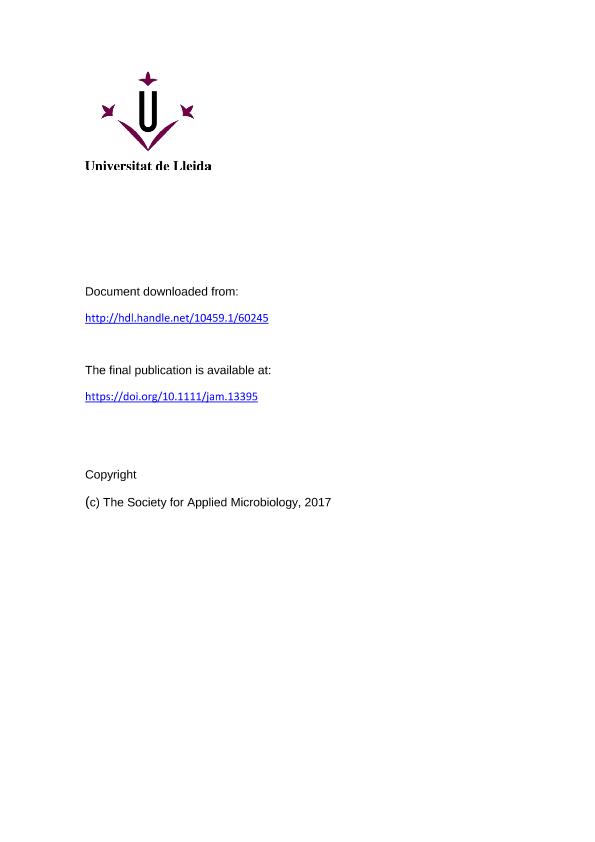Mostrar el registro sencillo del ítem
dc.contributor.author
Alonso, Veronica Andrea

dc.contributor.author
Cavaglieri, Lilia Reneé

dc.contributor.author
Ramos, A. J.
dc.contributor.author
Torres, Adriana Mabel

dc.contributor.author
Marin, S.
dc.date.available
2019-04-23T19:45:53Z
dc.date.issued
2017-04
dc.identifier.citation
Alonso, Veronica Andrea; Cavaglieri, Lilia Reneé; Ramos, A. J.; Torres, Adriana Mabel; Marin, S.; Modelling the effect of pH and water activity in the growth of Aspergillus fumigatus isolated from corn silage; Wiley Blackwell Publishing, Inc; Journal of Applied Microbiology; 122; 4; 4-2017; 1048-1056
dc.identifier.issn
1364-5072
dc.identifier.uri
http://hdl.handle.net/11336/74850
dc.description.abstract
Aims: The aim of this work was to use mathematical kinetic modelling to assess the combined effects of aW , pH, O2 availability and temperature on the growth rate and time to growth of Aspergillus fumigatus strains isolated from corn silage. Methods and Results: A full factorial design was used in which two factors were assayed: pH and aW. The aW levels assayed were 0·80, 0·85, 0·90, 0·92, 0·94, 0·96, 0·98 and 0·99. The levels of pH assayed were 3·5, 4, 4·5, 5, 6, 7, 7·5 and 8. The assay was performed at normal oxygen tension at 25 and 37°C, and at reduced oxygen tension at 25°C. Two strains of A. fumigatus isolated from corn silage were used. Kinetic models were built to predict growth of the strain under the assayed conditions. The cardinal models gave a good quality fit for radial growth rate data. The results indicate that the environmental conditions which take place during silage production, while limiting the growth of most micro-organisms, would not be able to control A. fumigatus. Moreover, pH levels in silage, far from limiting its growth, are also close to its optimum. Carbon dioxide at 5% in the environment did not significantly affect its growth. Conclusions: A need for a further and controlled acidification of the silage exists, as no growth of A. fumigatus was observed at pH 3·5, as long as the organoleptic characteristics of the silage are not much compromised. Significance and Impact of the Study: Aspergillus fumigatus is one of the major opportunistic pathogens able to cause illness such as allergic bronchopulmonary aspergillosis, aspergilloma and invasive aspergillosis to rural workers. Exposure of animals to A. fumigatus spores can result in infections, particularly in those organs exposed to external invasion, such as the airways, mammary gland and uterus at birth.
dc.format
application/pdf
dc.language.iso
eng
dc.publisher
Wiley Blackwell Publishing, Inc

dc.rights
info:eu-repo/semantics/openAccess
dc.rights.uri
https://creativecommons.org/licenses/by-nc-sa/2.5/ar/
dc.subject
Cardinal Parameters Model
dc.subject
Environmental Mycology
dc.subject
Fungi
dc.subject
Predictive Modelling
dc.subject
Predictive Mycology
dc.subject.classification
Otras Ciencias Biológicas

dc.subject.classification
Ciencias Biológicas

dc.subject.classification
CIENCIAS NATURALES Y EXACTAS

dc.title
Modelling the effect of pH and water activity in the growth of Aspergillus fumigatus isolated from corn silage
dc.type
info:eu-repo/semantics/article
dc.type
info:ar-repo/semantics/artículo
dc.type
info:eu-repo/semantics/publishedVersion
dc.date.updated
2019-04-16T20:39:09Z
dc.journal.volume
122
dc.journal.number
4
dc.journal.pagination
1048-1056
dc.journal.pais
Reino Unido

dc.journal.ciudad
Londres
dc.conicet.avisoEditorial
This is the peer reviewed version of the following article: Alonso, V. , Cavaglieri, L. , Ramos, A. , Torres, A. and Marin, S. (2017), Modelling the effect of pH and water activity in the growth of Aspergillus fumigatus isolated from corn silage. J Appl Microbiol, 122: 1048-1056. doi:10.1111/jam.13395 , which has been published in final form at https://doi.org/10.1111/jam.13395 . This article may be used for non-commercial purposes in accordance with Wiley Terms and Conditions for Use of Self-Archived Versions.
dc.description.fil
Fil: Alonso, Veronica Andrea. Universidad Nacional de Río Cuarto. Facultad de Ciencias Exactas, Fisicoquímicas y Naturales. Departamento de Microbiología e Inmunología; Argentina. Consejo Nacional de Investigaciones Científicas y Técnicas; Argentina
dc.description.fil
Fil: Cavaglieri, Lilia Reneé. Universidad Nacional de Río Cuarto. Facultad de Ciencias Exactas, Fisicoquímicas y Naturales. Departamento de Microbiología e Inmunología; Argentina. Consejo Nacional de Investigaciones Científicas y Técnicas; Argentina
dc.description.fil
Fil: Ramos, A. J.. Universidad de Lleida; España
dc.description.fil
Fil: Torres, Adriana Mabel. Universidad Nacional de Río Cuarto. Facultad de Ciencias Exactas, Fisicoquímicas y Naturales. Departamento de Microbiología e Inmunología; Argentina. Consejo Nacional de Investigaciones Científicas y Técnicas; Argentina
dc.description.fil
Fil: Marin, S.. Universidad de Lleida; España
dc.journal.title
Journal of Applied Microbiology

dc.relation.alternativeid
info:eu-repo/semantics/altIdentifier/doi/http://dx.doi.org/10.1111/jam.13395
dc.relation.alternativeid
info:eu-repo/semantics/altIdentifier/url/https://onlinelibrary.wiley.com/doi/abs/10.1111/jam.13395
Archivos asociados
